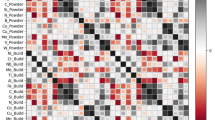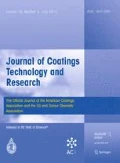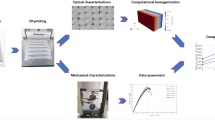Abstract
Microparticle composite thin films (MCTFs) have applications in a variety of fields, ranging from water filtration, to advanced energy storage, to medical devices. Variations in processing parameters during casting and solidification have been demonstrated to lead to morphological and therefore property changes in the final film. However, the wide range and number of possible combinations of parameters can make robust process–structure (PS) linkages a complex problem. Material informatics has shown to be well suited for developing PS linkages in other materials, but there are challenges that must first be addressed for MCTFs given the lack of separation between the characteristic length scales of the microstructure (i.e., particles, pores, etc.) and the film thickness. The objective of this work is to identify reduced-order spatial models and machine learning algorithms to address these problems. To achieve this, simulated microstructures of microparticle distributions based upon slot die coating simulations have been generated. Reduced-order representations of the microstructures were then created to capture variation in the microstructure across small slices through thickness of the film using two-point particle autocorrelation statistics and principal component analysis. Results showed that predictive PS linkages can be created using Gaussian process regression between the final film morphology and processing parameters; however, image size must be considered to ensure convergence in spatial statistics to increase accuracy.









Similar content being viewed by others

References
Yin, J, Deng, B, “Polymer-Matrix Nanocomposite Membranes for Water Treatment.” J. Membr. Sci., 479 256–275 (2015)
Kim, J, Van Der Bruggen, B, “The Use of Nanoparticles in Polymeric and Ceramic Membrane Structures: Review of Manufacturing Procedures and Performance Improvement for Water Treatment.” Environ. Pollut., 158 (7) 2335–2349 (2010)
Chou, W-L, Yu, D-G, Yang, M-C, “The Preparation and Characterization of Silver-Loading Cellulose Acetate Hollow Fiber Membrane for Water Treatment.” Polym. Adv. Technol., 16 (8) 600–607 (2005)
Srivastava, S, Schaefer, JL, Yang, Z, Tu, Z, Archer, LA, “25th Anniversary Article: Polymer-Particle Composites: Phase Stability and Applications in Electrochemical Energy Storage.” Adv. Mater., 26 (2) 201–234 (2014)
Wengeler, L, Schmidt-Hansberg, B, Peters, K, Scharfer, P, Schabel, W, “Investigations on Knife and Slot Die Coating and Processing of Polymer Nanoparticle Films for Hybrid Polymer Solar Cells.” Chem. Eng. Process. Process Intensif., 50 (5–6) 478–482 (2011)
Choi, K-J, Lee, J-Y, Shin, D-K, Park, J, “Investigation on Slot-Die Coating of Hybrid Material Structure for OLED Lightings.” J. Phys. Chem. Solids, 95 119–128 (2016)
Lee, S, Koo, J, Kang, SK, Park, G, Lee, YJ, Chen, YY, Lim, SA, Lee, KM, Rogers, JA, “Metal Microparticle - Polymer Composites as Printable, Bio/ecoresorbable Conductive Inks.” Mater. Today, 21 (3) 207–215 (2018)
Salernitano, E, Migliaresi, C, “Composite Materials for Biomedical Applications: A Review.” J. Appl. Biomater. Biomech., 1 3–18 (2003)
Chen, L-C, Liu, D, Liu, T-J, Tiu, C, Yang, C-R, Chu, W-B, Wan, C-C, “Improvement of Lithium-Ion Battery Performance Using a Two-Layered Cathode by Simultaneous Slot-Die Coating.” J. Energy Storage, 5 156–162 (2016)
Park, J, Shin, K, Lee, C, “Optimized Design for Anti-reflection Coating Process in Roll-to-Roll Slot-Die Coating System.” Robot. Comput. Integr. Manuf., 30 (5) 432–441 (2014)
Pryamitsyn, V, Ganesan, V, “Origins of Linear Viscoelastic Behavior of Polymer−Nanoparticle Composites.” Macromolecules, 39 (2) 844–856 (2006)
Cho, S-D, Lee, J-Y, Paik, K-W, “Effects of Particle Size on Dielectric Constant and Leakage Current of Epoxy/Barium Titanate (BaTiO/sub3/) Composite Films for Embedded Capacitors.” In: Advances in Electronic Materials and Packaging 2001 (Cat. No.01EX506) (2001)
Jancar, J, Douglas, JF, Starr, FW, Kumar, SK, Cassagnau, P, Lesser, AJ, Sternstein, SS, Buehler, MJ, “Current Issues in Research on Structure–Property Relationships in Polymer Nanocomposites.” Polymer, 51 (15) 3321–3343 (2010)
Cardinal, CM, Jung, YD, Ahn, KH, Francis, LF, “Drying Regime Maps for Particulate Coatings.” AIChE J., 56 (11) 2769–2780 (2010)
Akbarzadeh, V, Hrymak, AN, “Coupled Fluid-Particle Modeling of a Slot Die Coating System.” AIChE J., 62 (6) 1933–1939 (2016)
Dzinun, H, Othman, MHD, Ismail, AF, Puteh, MH, Rahman, MA, Jaafar, J, “Morphological Study of Co-Extruded Dual-Layer Hollow Fiber Membranes Incorporated with Different TiO2 Loadings.” J. Membr. Sci., 479 123–131 (2015)
Guillen, GR, Pan, Y, Li, M, Hoek, EMV, “Preparation and Characterization of Membranes Formed by Nonsolvent Induced Phase Separation: A Review.” Ind. Eng. Chem. Res., 50 (7) 3798–3817 (2011)
Baesch, S, Price, K, Scharfer, P, Francis, L, Schabel, W, “Influence of the Drying Conditions on the Particle Distribution in Particle Filled Polymer Films: Experimental Validation of Predictive Drying Regime Maps.” Chem. Eng. Process. Process Intensif., 123 138–147 (2018)
Chu, W-B, Yang, J-W, Wang, Y-C, Liu, T-J, Tiu, C, Guo, J, “The Effect of Inorganic Particles on Slot Die Coating of Poly(vinyl alcohol) Solutions.” J. Colloid Interface Sci., 297 (1) 215–225 (2006)
Campana, DM, Valdez Silva, LD, Carvalho, MS, “Slot Coating Flows of Non-colloidal Particle Suspensions.” AIChE J., 63 (3) 1122–1131 (2017)
Rebouças, RB, Siqueira, IR, Carvalho, MS, “Slot Coating Flow of Particle Suspensions: Particle Migration in Shear Sensitive Liquids.” J. Non-Newton. Fluid Mech., 258 22–31 (2018)
Siqueira, IR, Carvalho, MS, “A Computational Study of the Effect of Particle Migration on the Low-Flow Limit in Slot Coating of Particle Suspensions.” J. Coat. Technol. Res., 16 1619–1628 (2019)
Siqueira, IR, Rebouças, RB, Carvalho, MS, “Particle Migration and Alignment in Slot Coating Flows of Elongated Particle Suspensions.” AIChE J., 63 (7) 3187–3198 (2017)
Agrawal, A, Choudhary, A, “Perspective: Materials Informatics and Big Data: Realization of the “Fourth Paradigm” of Science in Materials Science.” APL Mater., 4 (5) 053208 (2016)
Hill, J, Mulholland, G, Persson, K, Seshadri, R, Wolverton, C, Meredig, B, “Materials Science with Large-Scale Data and Informatics: Unlocking New Opportunities.” MRS Bull., 41 (5) 399–409 (2016)
Jain, A, Hautier, G, Ong, SP, Persson, K, “New Opportunities for Materials Informatics: Resources and Data Mining Techniques for Uncovering Hidden Relationships.” J. Mater. Res., 31 (8) 977–994 (2016)
Jose, R, Ramakrishna, S, “Materials 4.0: Materials Big Data Enabled Materials Discovery.” Appl. Mater. Today, 10 127–132 (2018)
Rajan, K, “Materials Informatics: The Materials “Gene” and Big Data.” Annu. Rev. Mater. Res., 45 (1) 153–169 (2015)
Ferguson, AL, “Machine Learning and Data Science in Soft Materials Engineering.” J. Phys. Condens. Matter, 30 (4) 043002 (2018)
Ramprasad, R, Batra, R, Pilania, G, Mannodi-Kanakkithodi, A, Kim, C, “Machine Learning in Materials Informatics: Recent Applications and Prospects.” NPJ Comput. Mater., 3 (1) 54 (2017)
Lookman, T, Balachandran, PV, Xue, D, Hogden, J, Theiler, J, “Statistical Inference and Adaptive Design for Materials Discovery.” Curr. Opin. Solid State Mater. Sci., 21 (3) 121–128 (2017)
Sun, Y, Voorhees, PW, Shahani, A, Cecen, A, Gibbs, JW, Kalidindi, SR, Xiao, X, “Solidification in 4D: From Dendrites to Eutectics.” Microsc. Microanal., 23 (11) 320–321 (2017)
Moot, T, Isayev, O, Call, RW, Mccullough, SM, Zemaitis, M, Lopez, R, Cahoon, JF, Tropsha, A, “Material Informatics Driven Design and Experimental Validation of Lead Titanate as an Aqueous Solar Photocathode.” Mater. Discov., 6 9–16 (2016)
Gupta, A, Cecen, A, Goyal, S, Singh, AK, Kalidindi, SR, “Structure–Property Linkages Using a Data Science Approach: Application to a Non-metallic Inclusion/Steel Composite System.” Acta Mater., 91 239–254 (2015)
Wargo, EA, Hanna, AC, Çeçen, A, Kalidindi, SR, Kumbur, EC, “Selection of Representative Volume Elements for Pore-Scale Analysis of Transport in Fuel Cell Materials.” J. Power Sources, 197 168–179 (2012)
Altschuh, P, Yabansu, YC, Hötzer, J, Selzer, M, Nestler, B, Kalidindi, SR, “Data Science Approaches for Microstructure Quantification and Feature Identification in Porous Membranes.” J. Membr. Sci., 540 88–97 (2017)
Fullwood, DT, Niezgoda, SR, Adams, BL, Kalidindi, SR, “Microstructure Sensitive Design for Performance Optimization.” Prog. Mater. Sci., 55 (6) 477–562 (2010)
Mcdowell, DL, Choi, HJ, Panchal, J, Austin, R, Allen, J, Mistree, F, “Plasticity-Related Microstructure-Property Relations for Materials Design.” Key Eng. Mater., 340–341 21–30 (2007)
Steinberger, D, Gatti, R, Sandfeld, S, “A Universal Approach Towards Computational Characterization of Dislocation Microstructure.” JOM, 68 (8) 2065–2072 (2016)
Kaspi, O, Yosipof, A, Senderowitz, H, “RANdom SAmple Consensus (RANSAC) Algorithm for Material-Informatics: Application to Photovoltaic Solar Cells.” J. Cheminform., 9 (1) 1–15 (2017)
Brough, DB, Wheeler, D, Warren, JA, Kalidindi, SR, “Microstructure-Based Knowledge Systems for Capturing Process-Structure Evolution Linkages.” Curr. Opin. Solid State Mater. Sci., 21 (3) 129–140 (2017)
Cecen, A, Fast, T, Kalidindi, SR, “Versatile Algorithms for the Computation of 2-Point Spatial Correlations in Quantifying Material Structure.” Integr. Mater. Manuf. Innov., 5 1–15 (2016)
Latypov, MI, Kühbach, M, Beyerlein, IJ, Stinville, J-C, Toth, LS, Pollock, TM, Kalidindi, SR, “Application of Chord Length Distributions and Principal Component Analysis for Quantification and Representation of Diverse Polycrystalline Microstructures.” Mater. Charact., 145 671–685 (2018)
Yang, Z, Yabansu, YC, Al-Bahrani, R, Liao, W-K, Choudhary, AN, Kalidindi, SR, Agrawal, A, “Deep Learning Approaches for Mining Structure-Property Linkages in High Contrast Composites from Simulation Datasets.” Comput. Mater. Sci., 151 278–287 (2018)
Torquato, S, Haslach, H, Jr, “Random Heterogeneous Materials: Microstructure and Macroscopic Properties.” Appl. Mech. Rev., 55 (4) B62–B63 (2002)
Jung, J, Yoon, JI, Park, HK, Kim, JY, Kim, HS, “An Efficient Machine Learning Approach to Establish Structure-Property Linkages.” Comput. Mater. Sci., 156 17–25 (2019)
Rasmussen, CE, Williams, CKI, Gaussian Processes for Machine Learning. MIT Press, Cambridge (2006)
Simmons, JP, Bouman, CA, De Graef, M, Drummy, LF, Jr, Drummy, LF, Statistical Methods for Materials Science: The Data Science of Microstructure Characterization. Taylor & Francis Group, Milton (2019)
Mathworks. Gaussian Process Regression. 2020 [cited 2020 December 12th]; R2020b:[Available from: https://www.mathworks.com/help/stats/gaussian-process-regression.html?s_tid=CRUX_lftnav.
Author information
Authors and Affiliations
Corresponding author
Additional information
Publisher's Note
Springer Nature remains neutral with regard to jurisdictional claims in published maps and institutional affiliations.
This paper was presented at the 2020 International Society of Coatings Science and Technology Conference that was held virtually September 20–23, 2020.
Rights and permissions
About this article
Cite this article
Griffiths, P.R., Harris, T.A.L. Machine learning workflow for microparticle composite thin-film process–structure linkages. J Coat Technol Res 19, 83–96 (2022). https://doi.org/10.1007/s11998-021-00512-x
Received:
Revised:
Accepted:
Published:
Issue Date:
DOI: https://doi.org/10.1007/s11998-021-00512-x



